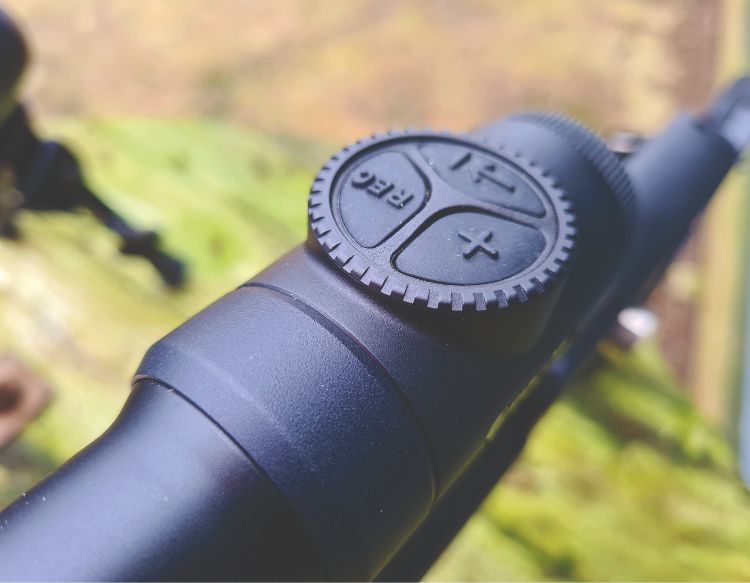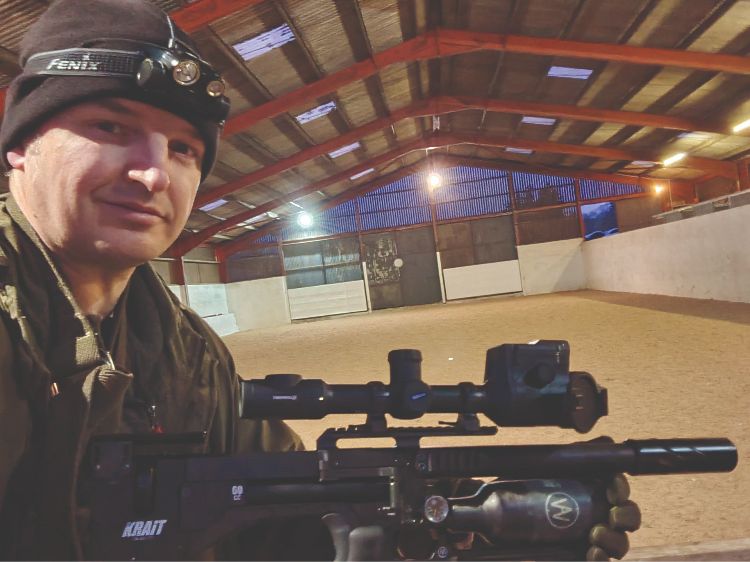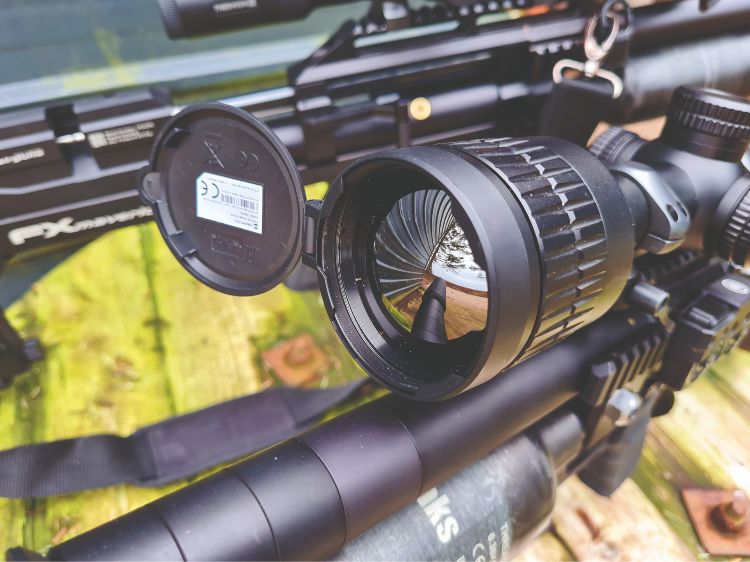I consider myself very lucky to be able to borrow some excellent kit, to review honestly, presenting both pros and cons. One drawback of pest control with night vision (NV) scopes, is although they let you target your prey precisely, they’re no match for thermal for spotting. Even a basic / relatively cheap thermal spotter (and no, thermal’s never actually ‘cheap’), is a total game changer. Whether on black- or white-hot, living mammals stand-out a mile as you scan any setting, providing the background is generally cool, to provide a good heat differential. This massively improves your efficiency, saving time and energy as you go about your pest control rounds. For a long time I wondered what a game changer it might be to actually do the targeting with a thermal scope, rather than just the spotting.
I LOVE MY JOB!
I’ve currently got two thermal scopes on test, which has allowed me for the first time to see things differently, plus compare them, and see how they compare to their higher-resolution NV counterparts. First, Ian Blackwood of BlackwoodOutdoors.co.uk kindly loaned me a high-end imager, the Pulsar Thermion2 LRF XQ50 Pro, and then HIKMICRO equally kindly loaned me the Stellar SH50. Both scopes have outstanding build quality, good internal batteries (plus back-ups) and both have menus instantly familiar to anyone who’s used their products before.
 Pulsar XQ50 LRF rear hotkeys: ‘+’ is stepped zoom, ‘Rec’ starts/ stops video
Pulsar XQ50 LRF rear hotkeys: ‘+’ is stepped zoom, ‘Rec’ starts/ stops video
THE TECHNICAL BIT (SORRY TONY)
For those unaware, thermal scopes detect and display the heat given off by mammals when there’s a differential against cooler backgrounds. This is a sophisticated business, using not a succession of glass lenses, but a single expensive Germanium objective lens. This focuses the faint heat directly onto a sensor, after which all magnification/zooming is electronic, not physical like a glass day scope’s optical system.
Thermal scopes are defined by; objective lens diameter, pixel array size (e.g. 384 x 288 as here, or 640 x 480 as in higher-spec sensors), and individual sensor pixel size. Generally, that’s 17um (micron) or 12um, the smaller size indicating that greater detail can be determined.
Nowadays, the real breakthroughs are in thermal sensitivity. This is described in mK NETD, or the ‘Net Extreme Temperature Differentiation’, measured in ‘milli-kelvins’. Basically, the smaller the number, the finer the temperature differential can be detected, which in turn, adds detail to the displayed image. For years <35 to <40mK NETD was standard, although now HIKMICRO is pushing boundaries with sensitivity of <20mK (AKA ‘sub-20’) in its latest sensors.
Once the sensor array size, pixel size and thermal sensitivity is defined, the next stage is packaging up this performance, and adding extras. Companies like PARD so far stuck with compact designs, hence their SA36 and SA62, where the numbers define the objective lens diameter; the larger number denoting higher base magnification, and narrower field of view for longer range use.
Pulsar have mostly stuck to a traditional tubed scope body, albeit filled with serious tech, and HIKMICRO also offers groundbreaking tubed scopes with thermal capability. In both cases basic functions are accessible from an upper/external rear three-button ‘hotkey’ control, with more comprehensive menus accessible via ‘jog-dial’ controls. These are housed within what would normally be the windage, elevation or parallax adjustment turrets. Focus controls are conventional, although on this Pulsar LRF model the objective focus is via a transverse ridged wheel behind the LRF – still a doddle to use.
 Business end of the XQ50 LRF, large Germanium lens gathers heat to display as light, whilst LRF module above measures distances quickly and precisely
Business end of the XQ50 LRF, large Germanium lens gathers heat to display as light, whilst LRF module above measures distances quickly and precisely
PULSAR THERMION2 LRF XQ50 PRO
Whilst both scopes have 384 x 288 sensors, this has 17um sensor resolution and sub 25mk NETD. The name’s a wee mouthful, denoting not only this as the latest iteration of a successful series of scopes, but also the sensor spec’ and added laser rangefinder functionality.
The next model up – the Thermion2 LRF XP50 – has a larger 640 x 480 sensor, but costs an additional £1,800! Pulsar scopes can be expensive, but if you can afford them, they include handy features like; stepped and finely incremental zoom; the menu system gives you unrivalled choices of reticle styles and colours; onboard battery life is generous, plus extra (proprietary) batteries can be added via the top turret.
All thermal devices and scopes must periodically pause to refresh the sensor (called Flat-Field Correction, or FFC). This can be done manually, but most of us leave it on auto. The hiccup here is that the image freezes for a second or so every few minutes, potentially causing a miss if it coincides with you squeezing off a shot.
Pulsar’s on-screen display includes a very discreet border top and bottom, where you’ll see a three-second countdown when the next refresh approaches – providing you check as you line up for a shot. I rarely remember and have been caught unaware a few times, just as I fired. The rats in question were still shot, but I wasn’t sure until I checked where they’d fallen afterwards. Both batteries have clear separate indicators, bottom-right on screen, although when you plug in the scope to charge the onboard battery, you must select between downloading the onboard 16GB memory, or charging.
 A farmer called for help with ferals in the stables: job done with the Thermion2 XQ50 and Krait
A farmer called for help with ferals in the stables: job done with the Thermion2 XQ50 and Krait
HIKMICRO STELLAR SH50
A simpler name and a more straightforward capability here (i.e. non-LRF), but also with excellent performance. The SH50 is the 50mm lensed 384 x 288px, 12um model (sub 35mk NETD), while the next model up the SQ50 has the 640 x 512px sensor, offering more detail, albeit for an extra £1k. Like the Pulsar, the onboard battery provides generous run time, and this can be toppedup by adding a 16340 battery under the top turret cap, for an extra hour’s run time.
Remove the right-hand turret cap (neatly retained by a cord), plug-in the supplied USB-C cable and a red LED indicates charging – green once complete. Internal memory is for videos and images, although the external microphone’s very sensitive, so beware of recording live commentary on a windy day. The left turret offering speedy zooming is great, so I didn’t really miss the incremental zoom using this. I head-shot a surprising number of rats at base mag (2.7x) or 2x zoom (5.4x mag) because when zooming further with either scope, the digital zoom’s pixellation naturally reduced the image definition. The 4x (10.8x) and 8x (21.6x) digital mag’ are other options, although obviously correspondingly more pixelated and so lower quality.
 The Stellar’s 50mm objective lens is more streamlined with a conventional focus ring and no onboard LRF, but still very sensitive indeed.
The Stellar’s 50mm objective lens is more streamlined with a conventional focus ring and no onboard LRF, but still very sensitive indeed.
FIELD TESTING
I mounted the (1.2kg/ 2.6lbs) Pulsar SQ50 on the lightweight AirMaks Arms Krait, and the HIKMICRO SH50 (same weight) on my Maverick Compact, both via excellent Hawke ‘Precision Medium Weaver’ 30mm mounts. These are new to me, but have two great features; not only Torx-screws for positively connecting upper and lower halves, but also a spring-loaded 20mm external lever, allowing positive tool-free tightening to your Picatinny rail. I say ‘sprung’ because once tight, the lever can be pulled outwards to adjust its position, keeping clear of fingers as you work your rifle’s action. During multiple sessions, I took each rifle/scope combo out to my local barns, guarding stored grain crops from rodents. There’s been noticeably more such protection required in the recent wintry conditions, as rats move indoors to escape the cold.
I zeroed each scope first at 12m, by firing into the plain reverse side of my 300mm square kitchen worktop off-cut. Thermal targets are available, or simply stick tinfoil onto your backstop with double-sided tape, but the beauty of thermal is – you don’t actually need a target for zeroing. You can simply fire into a solid piece of MDF or worktop, then use the resulting impact’s ‘glowing’ thermal dot as your aimpoint for subsequent shots. After zeroing with this closer target, I move it out to 30m and repeat the procedure, rifle fore end supported on my Trigger Sticks and Bog Ultralight clamp. I’ll publish videos for both of these sessions and my thoughts on each scope, having used both multiple times in identical situations.
PROS AND CONS OF THERMAL
I enabled the picture-in-picture (PIP) for both scopes, which has the benefit of offering an upper magnified area for precise targeting, simultaneously showing the wider angle main image. My local permission’s grain storage barn’s thick stone walls are riddled with rat runs, so at times I’ve spotted a pinpoint of ‘light’ (heat) in a wall, which is a rat within the wall itself, passing-by a hole in the mortar between the blocks. Several times, I’ve taken advantage and shot rats through these tiny holes, which you can’t do with an NV scope, unless the rat pauses to look out through the hole and you see tell-tale eye-shine. The disadvantage is, you then can’t always confirm a clean kill, although if the glow through the hole doesn’t move for the rest of the session, you know that rat was stopped in its tracks – job done!
Yes, it’s great to spot the tell-tale thermal signature of vermin, quickly and then target them immediately, but the downside is, when there are lulls in the action, you either scan around though the scope whilst holding the weight of your rifle in your arms, or you still need a separate thermal spotter. Also, there's a naturally lower resolution of the thermal images – quite a disappointment when you’re used to the precision of an HD night-vision image. The image balance can often be adjusted to improve the detail and definition of a rat’s heat signature, which although reducing the ‘stand-out’ contrast from the background, helps you to identify where to target. If contrast is too high and an end-on rat’s body is totally white, is it facing toward you, or away? That’s the difference between taking a 'bum' shot, and a head shot – the head shot’s always a cleaner kill.
 A 35m rat @4x (14x mag’) is clear-enough especially with the B&W ‘sparkle’ reticle, about to be head-shot with the Stellar.
A 35m rat @4x (14x mag’) is clear-enough especially with the B&W ‘sparkle’ reticle, about to be head-shot with the Stellar.
WHILE I’M DREAMING
My ultimate pest control scope would be NV, sensitive for dusk/dawn use and high definition by both day and night, but would also incorporate a wider-angle thermal sensor for spotting. Imagine an HD image allowing you to place a pellet between a rat’s eyes at 40m, whilst one PIP window offers zoomed image, and a second offers a wide-angle thermal view to spot other targets rapidly. Coincidentally, I spotted two new Pulsar scopes on Thomas Jacks’ Instagram page, combining a high-quality thermal sensor with an HD NV sensor. Such technology doesn’t come cheap, but I hope to check-out the Pulsar DXP50 and DXP55 at their stand at the British Shooting Show.
KIT USED
- HIKMICRO Stellar SH50 scope £1,999.99 www.blackwoodoutdoors.co.uk
- Pulsar Thermion2 LRF XQ50 Pro scope. £3,159.95
- Hawke Precision Weaver mounts £34.99
- Primos gen2 Trigger Sticks John Rothery Wholesale
- BOG Ultralight clamp £98.59 SportsmanGunCentre
CONCLUSIONS/COMING SOON
I met up for another mini-monster ratting session with Stuart (@Vermin Control Scotland -channel), and despite a sore back, thanks to painkillers I didn’t have to cut our session short. My two rifle’s magazine capacities might have been 18 shots, but it seemed like every minute or two I was changing then refilling magazines, and my final tally was exactly 200 rats shot in just three hours! By the time you read this I should have videos online to accompany this dual review – beware, some include live pest control -ratting. It’s NV so B&W/not graphic and always clearly labelled, but viewer discretion is required.
Both scopes performed brilliantly, although sadly during Wednesday’s return to the waste tip for another monster ratting session, my Maverick Compact let me down – and the Stellar – because it’s developed a slow leak. My pre-shoot zero was spot-on at both 15m and 25m, but a few times, I missed rats when the plenum hadn’t repressurised, so the shot fell a few inches low. After shooting 50 rats with the Stellar/ Maverick combo for one hour, I swapped to the Pulsar/Krait for the next two hours – and shot exactly 150 more!
Thanks very much to Blackwood Outdoors for the extended loan of the Thermion2, and to HIKMICRO for the Stellar. This is all outstanding kit, and I hope I’ve given some of you an insight into their capabilities.